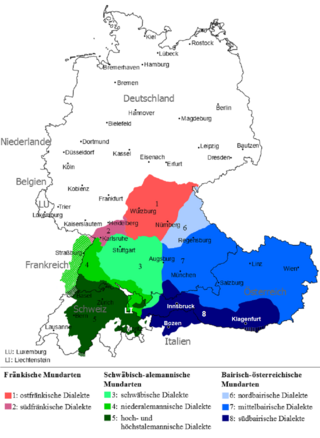| Revision as of 05:00, 3 November 2018 editMrevan (talk | contribs)Extended confirmed users625 edits the German article looks much more complete← Previous edit | Revision as of 05:13, 3 November 2018 edit undoMrevan (talk | contribs)Extended confirmed users625 edits Removing a possible WP:CONFLICT. I can't find this research project mentioned in Bavarian Academy of Sciences and Humanities, nor in the German version of that wiki page, nor in https://www.badw.deNext edit → | ||
| Line 24: | Line 24: | ||
| ] | ] | ||
| In the transitional area between ] in the northwest and the ] dialects in the southeast, East Franconian has elements of ] and ]. The same goes only for ] in adjacent {{lang|de|]}}. East Franconian is one of the German dialects with the highest number of speakers. | In the transitional area between ] in the northwest and the ] dialects in the southeast, East Franconian has elements of ] and ]. The same goes only for ] in adjacent {{lang|de|]}}. East Franconian is one of the German dialects with the highest number of speakers. | ||
| East Franconian is researched by {{lang|de|Mundartforschungsstelle der Bayerischen Akademie der Wissenschaften}} in {{lang|de|Fürth}}. | |||
| The scope of East Franconian is disputed, because it overlaps with neighbour dialects like Bavarian and ] in the south, ] in the west and ] in the north. | The scope of East Franconian is disputed, because it overlaps with neighbour dialects like Bavarian and ] in the south, ] in the west and ] in the north. | ||
| Line 41: | Line 39: | ||
| * {{de icon}} | * {{de icon}} | ||
| * {{de icon}} | * {{de icon}} | ||
| {{IndoEuropean-lang-stub}} | {{IndoEuropean-lang-stub}} | ||
Revision as of 05:13, 3 November 2018
| This article does not cite any sources. Please help improve this article by adding citations to reliable sources. Unsourced material may be challenged and removed. Find sources: "East Franconian German" – news · newspapers · books · scholar · JSTOR (December 2009) (Learn how and when to remove this message) |
You can help expand this article with text translated from the corresponding article in German. (November 2018) Click for important translation instructions.
|
| East Franconian | |
|---|---|
| Ostfränkisch | |
| Native to | Germany (Bavaria, Thuringia, Saxony, Baden-Württemberg, Hesse) |
| Native speakers | 4,900,000 (2006) |
| Language family | Indo-European
|
| Writing system | Latin (German alphabet) |
| Language codes | |
| ISO 639-3 | vmf |
| Glottolog | east2299 |
 1: East Franconian 1: East Franconian | |
East Franconian (Template:Lang-de), usually referred to as Franconian (Fränkisch) in German, is a dialect which is spoken in Franconia, the northern part of the federal state of Bavaria and other areas in Germany around Nuremberg, Bamberg, Coburg, Würzburg, Hof, Bayreuth, Meiningen, Bad Mergentheim, and Crailsheim. The major subgroups are Unterostfränkisch (spoken in Lower Franconia and southern Thuringia), Oberostfränkisch (spoken in Upper and Middle Franconia) and Südostfränkisch (spoken in some parts of Middle Franconia and Hohenlohe).

In the transitional area between Rhine Franconian in the northwest and the Austro-Bavarian dialects in the southeast, East Franconian has elements of Central German and Upper German. The same goes only for South Franconian German in adjacent Baden-Württemberg. East Franconian is one of the German dialects with the highest number of speakers.
The scope of East Franconian is disputed, because it overlaps with neighbour dialects like Bavarian and Swabian in the south, Rhine Franconian in the west and Upper Saxon in the north.
References
- East Franconian at Ethnologue (18th ed., 2015) (subscription required)
See also
External links
- A High German – East Franconian dictionary with sound files Template:De icon
- , from Mundartforschungsstelle der Bayerischen Akademie der Wissenschaften
- Linguistic atlas of Middle Franconia Template:De icon
- Linguistic atlas of Lower Franconia Template:De icon
This Indo-European languages-related article is a stub. You can help Misplaced Pages by expanding it. |